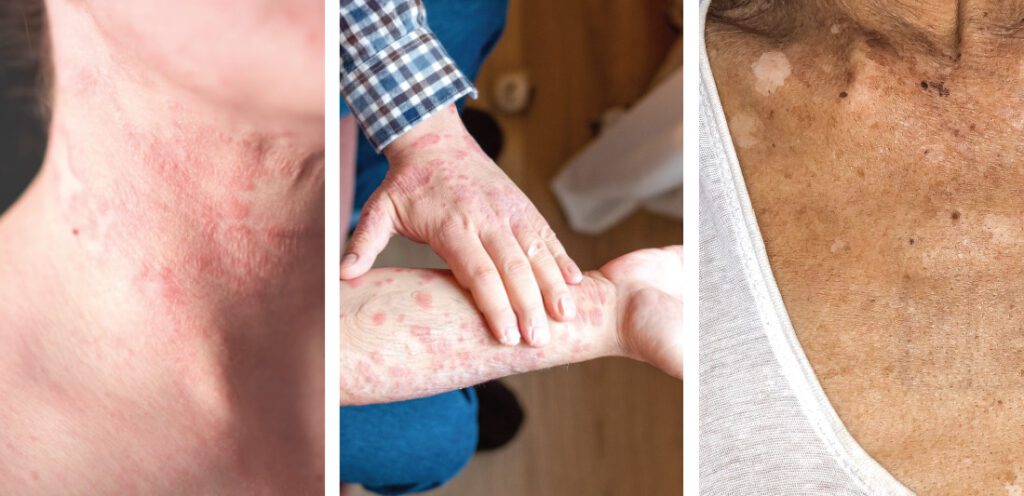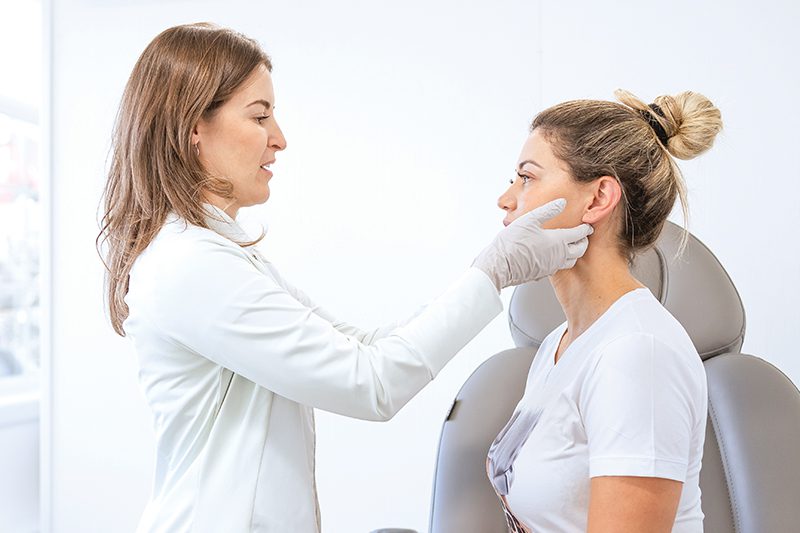Distinguishing the Conditions
Rashes are a common concern, but they’re often a source of confusion as well. We all know the feeling: you notice an itch that won’t go away, your skin feels warmer or more tender than usual, and then you notice bumps or discoloration. You’ve definitely got a rash, but what caused it?
The answer could be eczema or psoriasis, but it can be hard to tell these conditions apart. Here, we spoke with local experts to learn more about their differences and how to find relief from both.
What Is Eczema?
Atopic dermatitis, commonly known as eczema, is a chronic condition that causes recurring outbreaks of dry, itchy, and inflamed skin that are often triggered by external irritants. “Eczema usually appears as rough patches in the creases of the arms or legs, on the hands and feet, on the face, or the back of the neck,” says Dr. Deanna G. Brown of Four Bridges Dermatology & Cosmetics. “When eczema is caused by an allergy (allergic contact dermatitis), it can have a unique geometric shape or location that correlates to whatever triggered the rash.


For example, nickel allergy rashes often show up on the lower abdomen where your belt buckle rests.”
Symptoms Include:
- Dry, cracked skin
- Itchiness
- Inflamed or swollen skin that may be discolored
- Small, raised bumps
- Oozing and crusting
- Thickened skin
- Darkening of the skin around the eyes
- Scratching that leads to raw or sensitive skin
What Is Psoriasis?
Psoriasis is a chronic skin condition characterized by a scaly rash.
Psoriasis flares can last from a few weeks to several months and are often quite painful, but may or may not be itchy. “It commonly appears as well-defined, raised ‘plaques’ with scaling over the knees, elbows, scalp, and lower back, and can even affect your nails, causing discoloration and pitting. When psoriasis appears after an infection (guttate psoriasis), it may develop as small scaly red spots on the trunk, arms, and legs. Rarely, it also can look like widespread pus-filled bumps with very red skin,” Dr. Brown explains.



Symptoms Include:
- Cyclic outbreaks of rashes that range from mild and dandruff-like to severe, widespread outbreaks covering much of the body
- Rashes that tend to be shades of purple with gray scales on darker skin tones and shades of red with silver scales on lighter skin tones
- Small, scaling spots
- Dry, cracked skin that may bleed
- Itching, burning, or tenderness
Diagnosis
Though eczema and psoriasis can have similar symptoms, there are notable differences. “The key difference is that eczema is an impaired skin barrier with loss of moisture in the skin, while psoriasis is generally an overabundance of skin growth,” says Dr. Abby Russell of Galen Dermatology. “Some common clinical differences are that eczematous skin is more prone to secondary infections with crusting, oozing, or yellow drainage, while psoriasis occurs in areas of trauma or injury more readily than eczema would. Psoriasis is also associated with arthritis.” Additionally, Dr. Victor Czerkasij of Skin Cancer & Cosmetic Dermatology says, “Timing can also be a hint: psoriasis typically improves in spring and summer with increased sunlight.”



Still, determining the exact cause of a rash can be a bit tricky. Dr. Czerkasij explains, “There are multiple forms of eczema and five recognized types of psoriasis, so diagnosis requires careful examination of patient history and the skin.” When it comes to these exams, Dr. Brown says, “I consider how the rash looks and its location on the body. I also ask questions about a patient’s family history, personal history of asthma or allergies (for eczema) or arthritis (for psoriasis), and how long the rash has been developing. If I’m still unsure what is causing the rash, I will perform a simple skin biopsy.”
Treatment
Recent advancements have significantly expanded treatment options, particularly for more severe cases. “Mild eczema and psoriasis are treated very similarly. Both initially are treated with topical creams and ointments,” says Dr. Russell. “In more moderate to severe cases, patients often benefit from systemic medications, including biologics. These medications target parts of the immune system that have gone ‘haywire’ and are contributing to the disease.”
“For the 30 million Americans living with eczema and the 8 million with psoriasis, know that we have made amazing strides in understanding the nature of these diseases right at the cellular level,” Dr. Czerkasij says. “Biologics can target the exact cytokines (tiny proteins that communicate with one another) which are responsible for either eczema or psoriasis. There are both oral and injectable options, and some are approved for patients as young as six months!”
Advice From the Experts
If you or a loved one have been diagnosed with eczema or psoriasis, know that there are a number of ways to improve your daily experience and limit the risk of flares. Here are some additional words of advice from our local medical providers:







